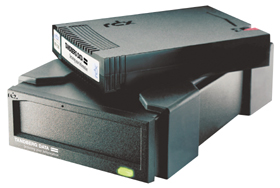
ASBIS Announces Availability of Tandberg's 160 GB RDX QuikStor Media
Tandberg Data has begun shipments of the RDX® QuikStor™ 160 GB Cartridge, a higher capacity removable cartridge for its disk-based storage device for data backup and archival.

Tandberg Data, the global supplier of backup and archiving solutions, announced the general availability of the RDX® QuikStor™ 160 GB Cartridge, a higher capacity removable cartridge for its disk-based storage device for data backup and archival, aimed at small and mid-sized businesses and professional power users. With the introduction of higher capacity cartridges, customers will benefit from a lower cost per Gigabyte. The new product is already available for ordering on ASBIS' B2B Marketplace.
 Since its introduction in late 2006, the RDX QuikStor has
experienced strong market acceptance. Global OEMs, system integrators and
resellers have tested the product and integrated it into their systems. At the
TechWorld Awards in June 2007, the RDX was voted the "Tape/Backup Product of the
Year", and earlier in the same month, the product received the "Disk Product of
the Year" award at the annual Storage Awards. Product reviews in international
press have described the product as "an innovative hard disk-based alternative
to tape for small-business backup operations" (PC Pro UK, February 07) and "a
fast and affordable alternative to tape for small-business server and desktop
backup" (Personal Computer World UK, March 07) and gave the product their
Recommended Awards.
Since its introduction in late 2006, the RDX QuikStor has
experienced strong market acceptance. Global OEMs, system integrators and
resellers have tested the product and integrated it into their systems. At the
TechWorld Awards in June 2007, the RDX was voted the "Tape/Backup Product of the
Year", and earlier in the same month, the product received the "Disk Product of
the Year" award at the annual Storage Awards. Product reviews in international
press have described the product as "an innovative hard disk-based alternative
to tape for small-business backup operations" (PC Pro UK, February 07) and "a
fast and affordable alternative to tape for small-business server and desktop
backup" (Personal Computer World UK, March 07) and gave the product their
Recommended Awards.
With the introduction of the 160 GB cartridges, Tandberg Data is delivering on the RDX Roadmap it introduced in 2006. Following the development of the mobile hard disks, higher capacity cartridges will continue to be introduced. With full backward and forward compatibility, the RDX QuikStor offers users investment protection whilst providing secure, fast and simple backup and archiving of their data.
About the RDX QuikStor
RDX QuikStor from Tandberg
Data is designed to replace current low-end tape technologies such as Travan,
DAT, and AIT, where ease of use and cost are prioritized. The device delivers
all the benefits of tape and disk without the risks inherent in either
technology. Like tape, the RDX QuikStor cartridges are removable and portable
for off-site storage, disaster recovery and archival applications. They can be
safely archived for more than a decade and it is an inexpensive backup and
recovery solution. Unlike other low-end tape media that may need to be replaced
after 50-100 uses, RDX QuikStor media has been built to endure over 10 years of
average use.
Consisting of either a 3.5 inch or 5.25 inch internal drive by connecting to the host either via S-ATA or an external drive bay via USB, the RDX QuikStor has been designed for high reliability. The cartridge houses a high-capacity mobile 2.5-inch hard disk drive in a reinforced, shock-proof design to protect the hard disk drive even when it is outside the drive case.
As well as offering professional-class reliability, the native 30 MB/sec transfer rate reduces the traditional backup window from hours to minutes. For example, it takes the Tandberg RDX QuikStor system less than an hour to backup 80 GB of native data and milliseconds to access files.
RDX QuikStor cartridges range in capacity from 40 GB, 80 GB, 120 GB and 160 GB. They are fully forward and backward compatible without limitation, meaning that future cartridges with ever-increasing capacities and faster data rates will work in legacy systems.
Pricing and Availability
The 160 GB cartridge for the RDX
QuikStor is now available through Tandberg Data's established channel of
distribution and reseller partners. The manufacturer suggested retail price
(MSRP) of the RDX QuikStor with a 160 GB cartridge including all necessary
accessories and Symantec Backup Exec QS backup software is $549. The MSRP of the
160 GB cartridge is $325.
The prices of the RDX QuikStor start at $349 for a drive with a 40 GB cartridge. Cartridge prices start at $115 for 40 GB.
Order the product via ASBIS' B2B Marketplace
Disclaimer:The information contained in each press release posted on this site was factually accurate on the date it was issued. While these press releases and other materials remain on the Company's website, the Company assumes no duty to update the information to reflect subsequent developments. Consequently, readers of the press releases and other materials should not rely upon the information as current or accurate after their issuance dates.
